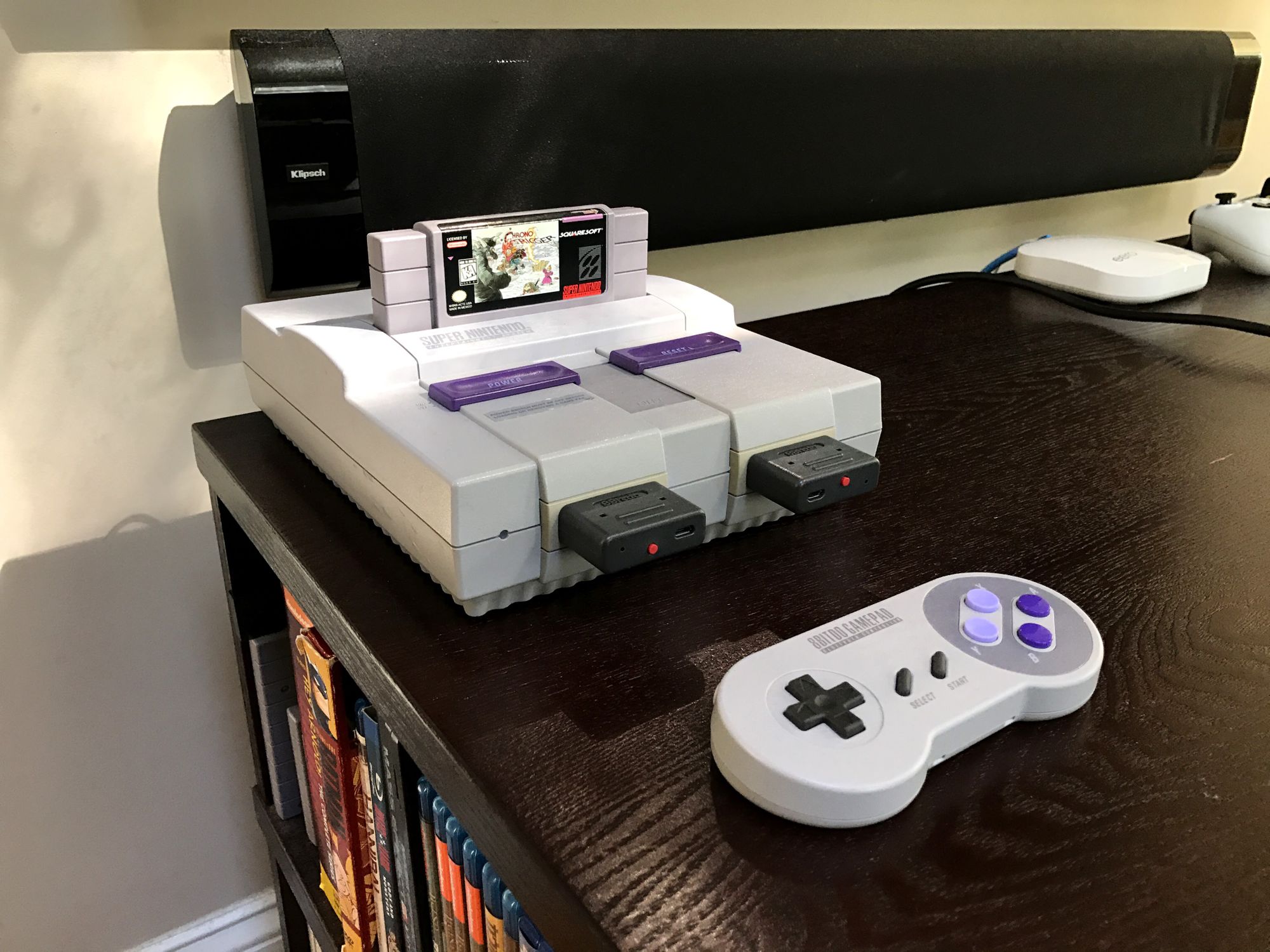Taking the Super Nintendo in to the modern era

The Super Nintendo is my favorite video game console of all-time. Great games, durable cartridges, and comfy analog controllers made for a delightful experience. Unfortunately, the SNES came out in August 1991 - long before we had HDTVs, digital video inputs, flash memory, and wireless technology for peripherals. The system's got composite video cables, wired controllers, and all of the games rely on battery-backed RAM to preserve their data. What's a modern gamer to do?
Luckily, there are some seriously dedicated enthusiasts out there, folks who have created all sorts of interesting hardware and upgrades for the SNES that make it easier to use with today's AV equipment and home layouts. Today, I'll go over a few of these products (all of which I use!) and hope that you find them as useful as I do!
Dealing with modern video
The cables bundled with the original SNES and its late-90s revision the SNES Mini are composite. The picture information is smooshed in to a single analog cable (yellow cable) and the sound broken up in to left and right channels (white and red cables). This made for a pretty blurry picture back in the standard definition days, and modern TVs & receivers tend to make a mess of composite video if they support it at all. While the SNES Mini is only capable of outputting composite video over its video-out port without a mod, the original SNES-001's video chip can actually output RGB, which looks a lot nicer.
To take advantage of the SNES-001's RGB capabilities, you'll need a new video cable. I've had great success with HDRetrovision's SNES component cable -- it'll take care of outputting a 240p image to your TV or receiver using the best video output possible on the SNES. Make sure your HDTV or receiver has a component video output on it for best results -- I've heard mixed reviews about using converters or upscalers.
Now you have the best possible picture, short of getting your hands on an exceedingly rare and expensive RGB television.
Wireless Upgrades
First, if you've never used a controller from Hong Kong-based 8bitdo, you're missing out. The company makes phenomenal classic controller replicas, and their SNES models (the SNES30 and SFC30http://www.8bitdo.com/sfc30) are better than the originals. They have great weight, work with any Bluetooth-compatible device that takes gamepad input, and last about 8-10 hours on a charge. They're also firmware-upgradable, so you can add new features after you buy them.
But how do we connect these new Bluetooth controllers in to our SNES? Enter another 8bitdo product, the Retro Receiver. This dongle plugs in to the controller ports on your SNES, giving them Bluetooth capabilities. After you pair your controllers to the Retro Receivers (a process that takes about 30-45 seconds the first time, be patient!), they'll automatically connect to the SNES when they're powered on.
The Save Issue
Back in 1991, before flash memory was cheap, SNES cartridges relied on special battery-backed RAM to keep your save data intact. The CR2032 batteries in each cartridge are good for a long time -- my copy of The Legend of Zelda: A Link to the Past lasted nearly 15 years -- but they're not permanent. Luckily, they're not too tricky to replace, and you can make some modifications once the cartridge is open to make future replacements even easier. I'll post the details step-by-step the next time I change a battery out so you guys can see.
If you just want to look the directions up on YouTube, you'll need some equipment:
- A soldering iron and some lead-free solder
- A CR2032 coin cell battery for each cartridge
- CR2032 battery holders -- I use Harwin Inc. S8421-45Rs
- A screwdriver with a 3.8mm Nintendo security bit tip to open the cartridge
But wait! What if you already have saves that you want to keep? Taking the battery out will wipe them out! To fix that problem, I present to you the Retrode 2. At its core, the Retrode is an SNES-to-USB adapter that will let you plug cartridges in, then play directly off of said cartridges in an emulator on your computer. However, you can also use it to back up and restore your save data and take a digital copy of the cartridge (called a ROM). With this gadget, you can back up your precious Secret of Mana save, change the battery out, then restore the data on to the cartridge. Then you're good for another decade or so!
Do you have any other interesting tools or tricks to make your classic consoles work better on modern equipment? Are you still hanging on to that Sony Trinitron TV? Let us know in the comments!
